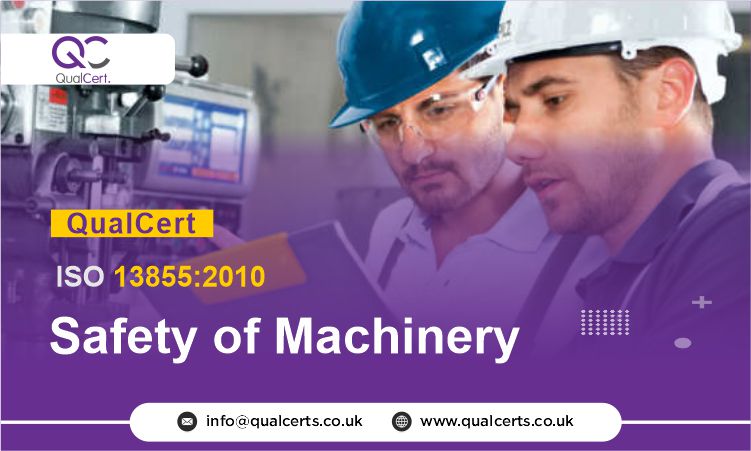In industrial settings, ensuring the safety of operators and workers is of paramount importance. Machinery and equipment present various hazards, including the risk of contact between human body parts and hazardous areas during operation. To address this concern, international standards such as ISO 13855:2010 have been developed to provide guidelines for positioning safeguards with respect to the approach speeds of human body parts.
ISO 13855:2010, titled “Safety of Machinery – Positioning of safeguards with respect to the approach speeds of parts of the human body,” establishes principles and recommendations for determining the appropriate positioning of safeguards to prevent contact between human body parts and hazardous areas of machinery. The standard considers factors such as approach speeds, response times, and the likelihood of contact during normal operation or foreseeable misuse.
ISO 13855:2010 is a valuable resource for promoting machinery safety by providing guidelines for the positioning of safeguards with respect to the approach speeds of human body parts. By adhering to the principles outlined in this standard and implementing appropriate safeguarding measures, manufacturers and users can effectively mitigate the risk of injuries and create safer working environments for personnel. Let’s prioritize machinery safety and work together to ensure compliance with ISO 13855:2010 and other relevant standards in our workplaces.
Study Units for ISO 13855:2010
The ISO 13855:2010 Safety of Machinery is a 30-credit qualification with a Total Qualification Time (TQT) of 180 hours, including 120 Guided Learning Hours (GLH). This program is meticulously crafted to deliver focused and efficient skill development in the field.
| Unit Ref# | Unit Title | Credits | GLH | TQT |
| QC04006 – 1 | Introduction to Machinery Safety and Risk Assessment | 5 | 20 | 30 |
| QC04006 – 2 | Human Factors and Safe Distance Calculations | 5 | 20 | 30 |
| QC04006 – 3 | Safety Devices and Control Systems | 5 | 20 | 30 |
| QC04006 – 4 | Implementation of Protective Measures | 5 | 20 | 30 |
| QC04006 – 5 | Compliance with ISO 13855 Standards | 5 | 20 | 30 |
| QC04006 – 6 | Risk Management and Incident Investigation in Machinery Safety | 5 | 20 | 30 |
Entry Requirements for ISO 13855:2010 in Machinery Safety
To enrol in the QualCert ISO 13855:2010 Safety of Machinery course, candidates should meet the following entry requirements:
Minimum Age
- Candidates must be at least 18 years of age at the time of enrolment.
Educational Background
- A minimum of a high school diploma or an equivalent qualification is required.
- A background in engineering, manufacturing, machinery operation, or occupational safety is advantageous.
Work Experience
- While not mandatory, prior experience in machinery safety, risk assessment, industrial operations, or related technical fields is highly beneficial.
- Practical industry experience enables candidates to apply ISO 13855:2010 standards effectively in workplace scenarios.
Language Proficiency
- Candidates must demonstrate good proficiency in English to fully comprehend technical documentation, safety requirements, and course materials.
- Strong English skills are also essential for participating in group discussions, workshops, and assessments.
Learning Outcomes for ISO 13855:2010 in Machinery Safety:
1. Introduction to Machinery Safety and Risk Assessment
Learning Outcomes:
By the end of this unit, learners will be able to:
- Understand fundamental concepts of machinery safety and hazard identification.
- Conduct risk assessments following established methodologies.
- Recognize common machinery hazards and their potential impacts.
- Apply risk assessment results to improve safety planning and design.
2. Human Factors and Safe Distance Calculations
Learning Outcomes:
By the end of this unit, learners will be able to:
- Analyze the role of human factors in machinery safety.
- Calculate safe distances to prevent operator injury in compliance with ISO 13855.
- Assess how ergonomic considerations influence safety device placement.
- Incorporate human behavior and reaction times into safety system design.
3. Safety Devices and Control Systems
Learning Outcomes:
By the end of this unit, learners will be able to:
- Identify types of safety devices used in machinery (e.g., guards, interlocks, emergency stops).
- Understand the operation and integration of control systems for safety.
- Evaluate the effectiveness of different safety devices in risk reduction.
- Specify appropriate safety devices based on machinery hazards and operational needs.
4. Implementation of Protective Measures
Learning Outcomes:
By the end of this unit, learners will be able to:
- Develop strategies for implementing protective measures on machinery.
- Ensure correct installation and maintenance of safety devices.
- Address challenges in retrofitting safety features on existing equipment.
- Promote a safety culture through training and operational procedures.
5. Compliance with ISO 13855 Standards
Learning Outcomes:
By the end of this unit, learners will be able to:
- Interpret the requirements of ISO 13855:2010 related to machinery safety.
- Apply the standard’s guidelines for determining safe positions of protective equipment.
- Prepare documentation demonstrating compliance with ISO 13855.
- Conduct internal audits to verify adherence to the standard.
6. Risk Management and Incident Investigation in Machinery Safety
Learning Outcomes:
By the end of this unit, learners will be able to:
- Apply risk management principles specific to machinery operations.
- Investigate machinery-related incidents to identify root causes.
- Recommend corrective and preventive actions to avoid recurrence.
- Integrate incident investigation outcomes into ongoing safety improvements.
QualCert ISO 13855:2010 – Safety of Machinery provides essential guidance on positioning protective equipment relative to human approach speeds. This course is designed to help professionals understand and apply the standard to prevent accidents and ensure compliance. It equips learners with practical knowledge to enhance workplace safety and safeguard operators in industrial environments.
1. Safety Professionals
This course is ideal for safety officers, managers, and auditors who are responsible for ensuring machinery safety in the workplace. It is designed for those looking to implement ISO 13855:2010 standards, enhance risk assessment procedures, reduce workplace hazards, and improve overall compliance with machinery safety regulations.
2. Engineers and Technicians
- Mechanical and industrial engineers involved in machinery design and operation.
- Maintenance engineers responsible for safe operation and servicing of machinery.
- Technical staff installing or modifying machinery.
- Engineers integrating safety standards into production lines.
- Professionals enhancing expertise in guarding and protective measures.
3. Compliance and Regulatory Staff
- Ensuring workplace compliance with safety regulations.
- Inspectors and regulators monitoring adherence to ISO standards.
- Legal and compliance officers managing occupational safety requirements.
- Preparing organizations for audits or certifications.
- Understanding legal responsibilities in machinery safety.
4. Managers and Supervisors
- Production and operations managers overseeing machinery-intensive environments.
- Supervisors ensuring staff safety around machinery.
- Implementing safety policies and procedures.
- Decision-makers evaluating machinery investments and modifications.
- Team leaders promoting a safety-first workplace culture.
5. New Entrants and Learners
This course is also suitable for fresh graduates, trainees, or anyone beginning a career in occupational health and safety. It provides foundational knowledge of machinery safety standards, helping learners understand international regulations, enhance employability, and prepare for a professional role in manufacturing or industrial sectors.
Asessment and Verification
Assessment Framework :
This qualification consists of 6 mandatory assignments designed to assess the learner’s understanding and practical application of the required skills and knowledge. The key elements of the assessment framework include:
- Comprehensive Assignment Structure:
The assignments are designed to cover a range of topics within the qualification, ensuring that learners demonstrate their competence across all essential areas. - Pass Requirement:
Learners must successfully complete all 6 assignments to meet the requirements for certification. Each assignment must meet the specified criteria and demonstrate sufficient understanding and application of the subject matter. - Assessment Process:
Each assignment is reviewed and marked by a qualified assessor, with feedback provided to support learner development. - Final Completion Criteria:
The successful completion of all assignments is necessary for certification. Only learners who meet the required standards across all assignments will be awarded the qualification.
Quality Assurance & Verification:
QualCert applies a rigorous, multi-layered quality assurance system to ensure the reliability, consistency, and integrity of all assessments and results.
1. Internal Quality Assurance (IQA)
Conducted by the approved training centre:
- Assignment Evaluation:
Centre-approved Assessors and Internal Quality Assurers (IQAs) review the assignments to ensure they meet the assessment criteria and learning outcomes. - Standardisation:
Regular standardisation sessions are held to maintain consistency in assessment and marking practices across all centre staff. - Feedback & Support:
IQAs ensure that learners receive constructive feedback to aid their progress and improve future submissions.
2. External Quality Assurance (EQA)
Conducted by QualCert:
- Independent Verification:
QualCert’s External Quality Assurers (EQAs) verify the completed assignments and assess the quality and fairness of the marking process. - Centre Audits:
EQAs audit the centre’s compliance with QualCert’s quality assurance standards, reviewing assessment practices, learner records, and overall delivery. - Final Certification:
After satisfying the EQA’s verification process, QualCert will officially issue the certification to the learner.
QualCert delivers all qualifications exclusively through its network of officially approved training centres.
For registration or further information, please contact your nearest approved training centre.

